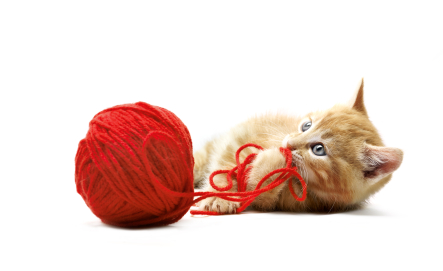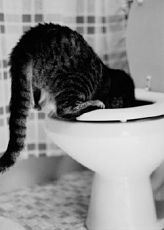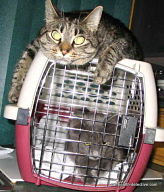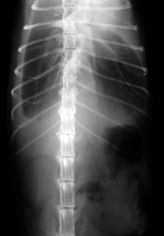Cat Digestive System...from mouth to rectum

The cat digestive system takes food on a journey through the body as it also undergoes multiple processing stages in order to nourish your cat. Most cats rank food pretty high so sometimes owners use food to bribe their cats; others use it to get their cats’ attention.
But aside from the psychological factors, food fulfills a cat’s basic need for nourishment. The digestive system goes to work once food enters the cat’s mouth. Those details are covered on the Cat Tongue and Finicky Cats pages.
The cat digestive system involves the tubular alimentary tract, which runs from the mouth to the rectum, as well as the liver and pancreas, both of which play important roles. Carnivores and hunters by nature, cats have systems that are designed for digesting prey.
The digestive tract has six basic functions: food uptake, food transport, food breakdown, nutrient absorption, nutrient storage and waste elimination.
During the digestion cycle, complex chemical processes take place. Enzymes trigger the breakdown of large foodstuffs into simpler compounds that are tiny enough to cross cell membranes. These simpler compounds are the nutrients the cells need for energy and proper function. The nutrients are proteins and amino acids, carbohydrates, fats and lipids, minerals, vitamins and water.
The best way to understand how the cat digestive system works is to follow food as it progresses through the system. The cat grabs the food with its teeth and lips. Some chew the pieces, while others swallow them whole (like our cat Max). In the mouth, saliva moistens and lubricates the food so it’s more easily swallowed.
This differs from humans because human saliva contains enzymes that start the food breakdown process right away. The tongue then pushes food back through the pharynx into the esophagus. Located mainly in the chest cavity, the esophagus is the part of the alimentary canal that connects the mouth to the stomach. Food immediately moves from the esophagus into the stomach.
The stomach, which is positioned in the abdominal cavity’s left side behind the liver, is the body’s adjustable reservoir for food and liquids. Food that reaches the stomach mixes with gastric secretions. Glands secrete hydrochloric acid and digestive enzymes which start the food breakdown process.
Other glands secrete mucus that thinly coats the mucosa (the alimentary tract’s lining), protecting it from damaging acid and enzymes. Once food has been mixed and treated with the acid and enzymes, it passes into the intestinal tract for final digestion and absorption in the cat digestive system.
Continuing on the path of the cat digestive system is the three part small intestine. The shortest segment, which receives the outflow from the stomach, is the duodenum. As food passes through the duodenum, it mixes with bile.
Bile is a fluid that neutralizes the stomach acid (greenish to yellowish in color), emulsifies and helps absorb fat, and carries some waste. Bile is created by the liver, stored in the gall bladder and passes to the duodenum via the bile duct.
As the bile mixed with food now passes through the duodenum, pancreatic enzymes get added. The pancreas runs alongside the duodenum and empties its enzymes into the intestines through the pancreatic duct. Pancreatic secretions also neutralize stomach acid, and enzymes aid the digestion of carbohydrates, fats and proteins.
Without these enzymes, the body would be unable to absorb nutrients because they would not be broken down enough to pass through the intestinal mucosa into the blood
The intestinal mucosa has microscopic, fingerlike projections called villi, which are covered with even smaller microvilli. This arrangement maximizes the surface area of the hollow, mucosa-lined intestinal tubes, and provides more absorptive surfaces for nutrients in the cat digestive system.
Following the duodenum is the jejunum, the small intestine’s largest segment, which can have up to eight loops. The jejunum is the cat digestive system tracts’ most nutrient-absorptive portion. Capillaries in the microvilla carry nutrients to larger veins that pool to form the portal vein. The portal vein carries the nutrients to the liver for further filtering and processing.
A cat’s liver comprises four lobes and may fill up to one quarter of the abdominal cavity in the cat digestive system. The liver is an amazing organ with hundreds of functions, not all related to digestion. Some of its most important functions are creation of proteins, storing carbohydrates, fat metabolism and removing old red blood cells and waste products from the blood.
The liver also regulates the nutrients level in the blood. The nutrients are in forms that can be utilized on a cellular level. Blood that leaves the liver enters the general circulation and nourishes cells all over the body.
Since blood traveling away from the intestines passes through the liver, the liver is exposed to many infectious agents, metabolic waste products and toxins. But damage is often temporary thanks to the liver’s regenerative capacity. Amazingly, as much as 70-80% of a liver can be impaired before functional problems become apparent.
One familiar sign of liver disease is jaundice, a yellow discoloration of the skin, mucous membranes or blood plasma. The yellow pigment comes from a metabolic product called bilirubin. High levels of bilirubin will lead to high levels in the urine, turning it a dark orange color. Multiple causes of this condition exist, but the most common in cats is impairment of the bile flow. Jaundice is never a normal condition in a cat, so if you notice this condition, call your vet.
Materials that pass through the jejunum that are not absorbed by the microvilla continue on into the ileum, which links the small intestine to the large intestine, continuing on the path of the cat digestive system.
The first part of the large intestine is the cecum. It is analogous to the human’s appendix in that it is a diverticulum without an integral function. The cecum leads into the colon, which is the site of water resorption and fecal formation. As the colon passes through the pelvic canal, it becomes the rectum.
Not every nutrient or drop of water is extracted from food as it passes through the alimentary canal; some parts are non-digestible. These leftover components of foods make up feces. The rectum stores feces until they are passed out of the body through the anal canal and anus.
The cat digestive system and its problems count among the most common health problem. Vomiting and diarrhea are often the result, but the causes are not always easily found. The possibilities are so numerous that it’s better to discuss the diagnostic tools used to zero in on the actual cause.
Owner observation is important to determining causes of gastrointestinal problems. Most owners are familiar with the posture and sound their cats make when spitting up a hairball…a normal cause of vomiting. Eating something they shouldn’t is another cause of vomiting or diarrhea, or you can have cat like our Max that is simply a pig and wolfs food too fast.
Food intolerance can also trigger vomiting or diarrhea. Owners should make note of what foods they offer, including brand, type and flavor. In this case, controlling gastrointestinal upset may be as easy as removing one specific food type from the cats diet.
Veterinary examination is the next step in finding the cause of gastrointestinal irregularity. The vet considers the cat’s history and gives a thorough exam which focuses on the cat’s mouth and feeling the organs within the abdominal cavity. If these steps fail to uncover the specific cause for the diarrhea and vomiting, additional testing is needed of the cat digestive system.
Examining the feces can reveal the presence of gastrointestinal parasites, such as worms or protozoa. Eggs or entire one-celled organisms can be seen in a microscopic exam. The tapeworm, however, is not easily observed on a fecal exam because it doesn’t frequently pass eggs.
The best way to diagnose tapeworms is by observing the worms segments when they pass out of the cats’ rectum. They appear as wiggly, rice-like worms and when they dry up they look like sesame seeds.
A cat that is active, eating and not losing weight is unlikely to have a serious problem and it can be assumed that the cat digestive system is fine. But a cat that cannot hold food or water down or that is losing weight is of more concern. Age also factors in because certain disease affects cats in different stages of life. Worms tend to more often affect kittens while intestinal cancer is more common in older cats.
The next diagnostic might be x-rays of the abdominal cavity. X-rays can show organs that are out of proper alignment, certain foreign objects that have been accidentally ingested, and some obstructions or tumors. Many cats that have gastrointestinal disease have normal x-rays but if a vet suspects ulceration or obstruction despite a normal X-ray, he may order barium upper GI series.
For this test, cats take an oral contrast
agent that passes through their alimentary tracts. Normal cats have a very
rapid GI transit time and contrast can travel from mouth to rectum in about one
hour. The vet takes x-rays sequentially until the contrast agent reaches the
rectum. If an obstructive lesion is
present, the contrast may not reach the rectum or will take an unusually long
time to reach it. The cat digestive system is a long route.
Gastrointestinal disease can affect blood cell counts, protein and mineral levels and other organ function. Thus, blood tests can add valuable information to a diagnosis regarding the cat digestive system. Blood tests can also uncover liver inflammation and a blood test called a bile acid test can preliminarily assess liver function abnormalities.
But routine blood testing cannot assess feline pancreatic function. For that, specialized pancreatic tests are needed where the blood is sent away to a special laboratory and results are not immediate.
Abnormal blood tests can point to liver disease, though the results do not indicate specific diseases. For a more in depth diagnosis of liver disease, the best test is a liver biopsy. There are two ways to do this. The less invasive way is an ultrasound-guided needle biopsy, in which the abdominal cavity is examined. The liver, gall bladder and bile ducts are scanned, and abnormal regions may be detected.
After a mild sedative is given, a needle is inserted through the skin and into the liver. This type of biopsy can provide good results but it is limited because only a small number of liver cells are obtained for analysis. A second biopsy method is exploratory surgery. It is more complicated but a larger tissue sample can be obtained. During surgery, the liver can also be visualized and palpated, providing more information. Each diagnostic tool has its risks and benefits.
Diagnosing intestinal disease may require an intestinal biopsy. Again, there are two ways. The least invasive procedure involves using a fiber-optic endoscope. The cat goes under general anesthesia and the endoscope is passed from the mouth, down the esophagus, into the stomach and then into the intestine. If large intestinal disease is suspected, the endoscope can also be passed in through the anus and into the colon. Small, claw-like arms grab pieces of the mucosa, which are submitted for biopsy.
The endoscope allows the vet to look at the alimentary canal’s lining, and brings into view any ulcerations or foreign objects in the scope’s path. This procedure has limits also. Only the inside of the tubular alimentary tract can be examined, and the endoscope can only pass a certain distance into the intestines.
If the problem is located farther down the cat digestive system canal, it will not be found. Very small tissue samples are obtained, and they are only the mucosa lining.
However, surgical biopsies contain all layers of the intestine. During surgery, the entire abdominal cavity and its organs can be observed and palpated. Recovery from surgical biopsy is longer because the cat will need intravenous feeding while the intestine heals.
If your cat suffers from gastrointestinal diseases, you should discuss with your vet how far you would like to go with the procedures. Costs range from the relatively inexpensive fecal test to expensive nursing care, hospitalization and surgery. An owner has to consider and weigh both personal feelings and finances.
Not all cases require extensive diagnostic tests. Many times a vet will prescribe medications…such as antibiotics, anti-spasmodic, motility regulators and anti-inflammatories…and observe the cat’s response. Cats that become dehydrated need fluid supplements.
Diet can have a significant impact on gastrointestinal disease. Depending on the clinical signs, a vet may also treat a cat using dietary manipulation. He may prescribe a special high-fiber diet or foods that are easily digested or hypoallergenic.
Some cats respond better to canned food than dry food. But not every cat is agreeable to dietary treatment, and limiting their diet can be more difficult in a multicat household.
Delivering nutrition to each body cell is a complex process. Each mouthful of food undergoes multiple processing steps before it is transformed into useable components. A cat with gastrointestinal disease may have vomiting and diarrhea, which could indicate mild to severe problems.
Your veterinarian will work with and your cat to determine treatment and diagnostic options. There are many courses of action, and often there is not one clear path to choose. Owners can protect their cats’ gastrointestinal tracts by feeding proper food diets, keeping foreign objects out of their reach, limiting treats and table food, and by obtaining vet advice if problems happen.
Related Articles......
Return from Cat Digestive System to Cat Health Homepage
Having trouble finding what you need? Cat Health Index & Site Map
OR
Do you have a question to ask?...Questions
OR
Do you have a cat story to share?...Simply click here to go to that page!
Copyright@2010-2020 All rights reserved.Cat-health-detective.com
This website is information only. Consult a veterinarian for medical assistance

"Like Us" on Facebook
or...
"Like Us" here



















